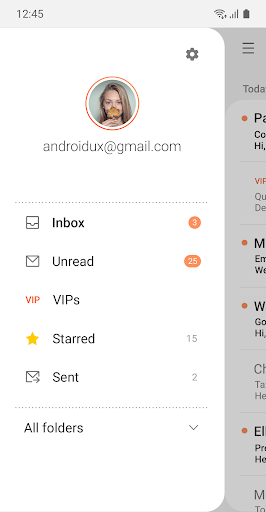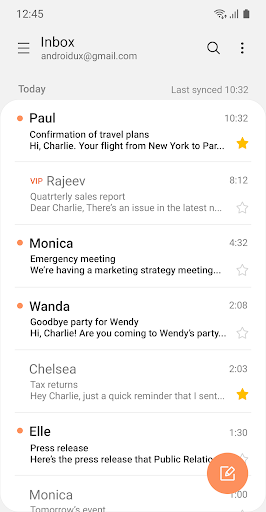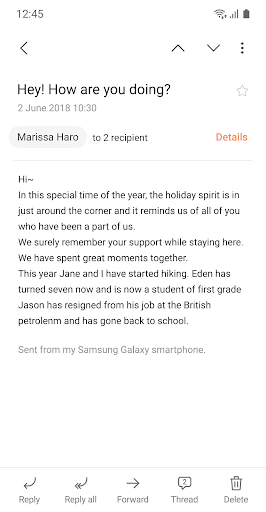| Samsung Email ★ 4.4 |
|
| ⚙️Developer | Samsung Electronics Co., Ltd. |
| ⬇️Downloads | 5,000,000,000+ |
| 📊Category | Productivity |
The Samsung Email app is a powerful and feature-rich email client designed for Samsung devices. It provides users with a seamless and efficient email management experience, offering a range of features and customization options. With its user-friendly interface and integration with Samsung’s ecosystem, the Samsung Email app is a popular choice for individuals and businesses alike. In this article, we will explore the features, benefits, pros, and cons of the Samsung Email app, and delve into real user reviews to provide you with a comprehensive understanding of its capabilities.
Features & Benefits
- Unified Inbox and Multiple Account Support: The Samsung Email app allows users to manage multiple email accounts in one place, providing a unified inbox for streamlined email management. Whether you have personal and work accounts or multiple email addresses for different purposes, this feature enables you to access and organize all your emails conveniently.
- Intelligent Email Organization: The app offers intelligent email organization features, such as automatic email categorization and priority inbox. It intelligently separates emails into primary, social, and promotional categories, reducing clutter and helping you focus on the most important messages. This feature saves time and improves productivity by ensuring that important emails are not buried in a flood of less relevant ones.
- Customizable Interface and Themes: The Samsung Email app allows users to personalize their email experience by customizing the interface and choosing from a variety of themes. You can select a color scheme or background that suits your preferences, making the app visually appealing and tailored to your style.
- Advanced Search and Filters: With the app’s advanced search and filtering capabilities, finding specific emails becomes effortless. You can search by keywords, sender, subject, or date range, making it easy to locate important emails or conversations. Filters enable you to sort emails based on criteria like unread status, attachments, or importance, further enhancing email organization.
- Integration with Samsung’s Ecosystem: As a native Samsung app, the Samsung Email app seamlessly integrates with other Samsung services and apps. It works in harmony with the Samsung Calendar app, allowing you to manage your schedule and email appointments seamlessly. Integration with Samsung’s Knox security platform ensures that your emails and attachments are protected, providing peace of mind for sensitive communications.
Alternative Apps
Newton Mail:?Newton Mail is a feature-packedemail app that focuses on productivity, with features like read receipts, email scheduling, and powerful integrations with other productivity tools.
Apple Mail:?Apple Mail is the default email client for Apple devices, offering a clean interface, intuitive features, and seamless integration with other Apple applications.
Spark:?Spark is a popular email client known for its smart inbox organization, intelligent email sorting, and collaboration features that enhance productivity.
Blue Mail:?Blue Mail is a versatile email client that supports multiple email accounts, offers customizable UI, and provides powerful features such as unified inbox and smart notifications.
Pros & Cons
Frequently Asked Questions
To add a new email account, open the Samsung Email app and tap on the menu icon (three horizontal lines) in the top left corner. Select “Settings” from the dropdown menu, then tap “Add Account.” You will be prompted to choose your email provider or enter your email details manually. After entering your email address and password, follow the on-screen instructions to complete the setup process. Yes, you can customize notifications for each email account. Go to “Settings” within the app, select the specific email account you want to customize, and tap on “Notifications.” Here, you can enable or disable notifications, choose different notification sounds, and set priority levels. This allows you to manage how and when you receive alerts for each account. To set a default email account, access the “Settings” menu in the Samsung Email app. Scroll down to the “Default Account” option and select it. Choose the email account you wish to set as your default. This account will automatically be used for sending emails unless you select a different one during composition. Yes, the Samsung Email app supports email synchronization across multiple devices. Ensure that your email account is configured with IMAP or Exchange settings, which allow for real-time syncing. Once set up, any changes made, such as reading or deleting emails on one device, will reflect across all other devices where the account is logged in. To organize your emails into folders, open the Samsung Email app and navigate to your inbox. Tap on the menu icon and select “Folders.” Here, you can create new folders by tapping the “+” icon, naming the folder, and saving it. To move emails into folders, select the emails you want to categorize, tap on the “Move” option, and choose the desired folder. If the Samsung Email app is not syncing, first check your internet connection to ensure you are online. Then, go to “Settings” in the app and select the affected email account. Make sure “Sync Email” is enabled. If issues persist, try removing and re-adding the email account. Additionally, clearing the app cache may resolve any temporary glitches affecting synchronization. The Samsung Email app generally allows attachments up to 25 MB, which is the standard limit for most email services. However, if your attachment exceeds this size, consider using cloud storage options like Google Drive or OneDrive. You can upload the file to the cloud and share a link via email, bypassing the attachment size limitation. To enhance security in the Samsung Email app, make sure to enable security features such as two-factor authentication for your email account. Utilize SSL/TLS encryption during setup to protect your data while sending and receiving emails. Regularly update the app to ensure you have the latest security patches, and avoid connecting to unsecured Wi-Fi networks when accessing sensitive information.How do I add a new email account to the Samsung Email app?
Can I customize notifications for different email accounts in the Samsung Email app?
How do I set a default email account in the Samsung Email app?
Is it possible to sync my emails across multiple devices using the Samsung Email app?
How do I organize my emails into folders within the Samsung Email app?
What should I do if the Samsung Email app is not syncing my emails?
Can I use the Samsung Email app to send large attachments? What are the size limits?
How can I ensure my emails are secure while using the Samsung Email app?
Screenshots
 |
 |
 |
 |





